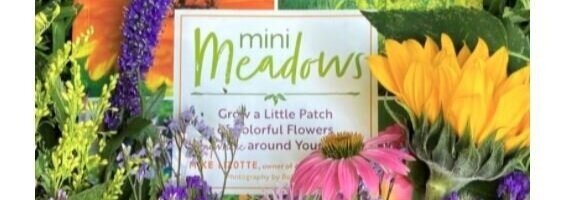
Mini Meadows:
Grow a Little Patch of Flowers Anywhere Around Your Yard
By Mike Lizotte (September 2019)
The author prefaces his book with how he became interested in seeds and meadows. He began helping out at a seed store in his hometown when he was fourteen years old. First, he did outdoor maintenance and mowed the display gardens. Then he began packing seeds. Mr. Lizotte explains he learned about seeds first and then started to recognize the flowers and plants that grew from the seeds. He was fascinated by seeds. In 2009, he took over the seed company with a business partner.
Mr. Lizotte defines a meadow as not simply a grassland, but any planting area with annual and perennial flowers, native and non-native plants (including grasses) that bloom from spring through early fall. The area has a loose and naturalistic style. He considers a meadow to be not just a large plot; it could be any size, even an area as small as a planter box.
Meadows provide many advantages for the garden and the gardener:
1. Meadows cultivate beauty.
2. They provide fresh-cut flowers.
3. They can be used to engage children in gardening.
4. Meadows conserve water.
5. They support pollinators and attract birds.
6. Meadows are generally low maintenance once established.
Chapters address the planning of your meadow: defining the purpose of your meadow, evaluating the potential site, determining when to plant, and how to prepare the soil. There is a chapter that gives the information necessary to establish your own meadow.
Another section walks through how to plant a meadow. Subjects include how to determine the amount of seed needed, whether to buy seed mixtures or select specific plant seeds, when to plant, and whether to us annuals or perennials. There’s also advice on how to maintain the meadow, including an expected growth calendar for 30-, 60- and 90-day periods.
Later chapters describe meadows created for special purposes such as preventing soil erosion, improving a boggy area, successfully growing flowers between a sidewalk and the street, encouraging pollinators or wildlife, and improving deer resistance. There is also guidance for planting meadows by region of the country.
Although Mini Meadows is a short book, it provides an excellent, down-to-earth description of how to create a meadow garden and it gives several lists of suitable plants to use in a meadow planting. The book has inspired me to consider planting a mini-meadow garden in my backyard. I hope it will inspire you, too.
Holly Sparrow, Headwaters Master Gardener